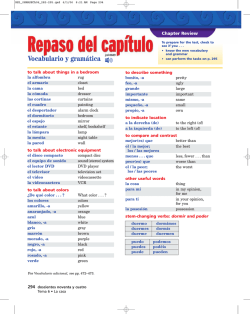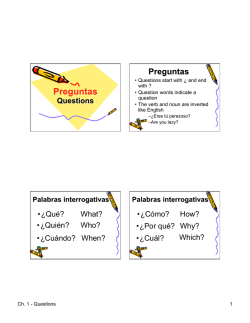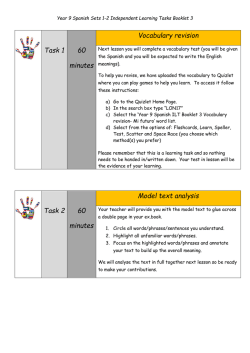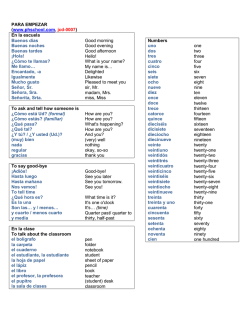
Practice and Communicate
sp04_te_xxxii_13.qxd 8/6/03 6:14 PM Page 8 Practice and Communicate Objectives • Talk about things you and other people do • Write a poem describing what you are like and the things you do ¿Qué haces? Presentation Resources: Audio Program: CD 1, Para empezar, Track 5 Suggestions: Use the transparency to aid understanding as students listen to the dialogue. Then draw a large Venn diagram on the board. Label the left side invierno, the right side verano, and the section where the circles overlap, las dos. Mime activities that can be done in winter, in summer, or in both seasons and have students guess the activity and the season. Have volunteers write the activities on the diagram. Have pairs of students reread the dialogue, replacing the activities shown with other activities from the Venn diagram. Pepe 13 Standards: 1.2 •••••••••••••••• Resources: Audio Program: CD 1, Para empezar, Track 6; Resource Book: Para empezar, Audio Script; Practice Answers on Transparencies 1. bailar (Paula) 2. leer (Pepe) 3. escuchar música (Paula) 4. montar en bicicleta (Paula) 5. cantar (Paula) 6. nadar (Pepe) 7. correr (Paula) 8. tomar el sol (Pepe) Extension: Play the Audio CD again and have students act out the activities. —Pues, paso tiempo con mis amigos: escuchamos música, cantamos y por la noche bailamos. Lo que más me gusta hacer es practicar deportes. —¿Qué deportes practicas? tivid 13 —Monto en bicicleta o corro todos los días para hacer ejercicio. Practico deportes todo el año. ¿Y tú, Pepe? —No soy muy deportista. A veces nado, por eso me encanta el verano. Generalmente tomo el sol y leo. ¿Qué haces en tus vacaciones de verano? —En el verano a veces patino y también monto en monopatín con mis amigos. ad Focus: Reading and listening comprehension Suggestions: Ask students how they would describe Sonia (deportista, sociable, talentosa) and Pepe (no deportista, un poco perezoso, reservado). Tell students that keeping Sonia and Pepe’s personality traits in mind will help them identify the activities that each likes. Script and Answers: —¡Uy! No me gusta nada el invierno. Paula, ¿qué te gusta hacer en el invierno? Ac Ac ad tivid Paula Escuchar Paula y Pepe Divide una hoja de papel en dos columnas. En la primera columna escribe Paula, y en la segunda escribe Pepe. Escucha una lista de actividades. Si Paula hace la actividad, escribe el número de la actividad debajo de Paula. Si Pepe la hace, escribe el número debajo de Pepe. Usa los dibujos para ayudarte. 8 Paula Pepe ocho ¿Qué haces? Universal Access Block Schedule ••• •• • • • • • • • • • • • Assign each student a regular verb. Have one student start a story by forming a sentence using their verb. Have that student pick the next student who will continue the story by creating a sentence with his or her verb. Continue until the story ends or every student has had a turn. 8 Advanced Learners Students with Learning Difficulties Have students prepare a four-seasons guide to recreational activities in your area for Spanishspeaking tourists. They can group activities according to type, and then tell where each can be performed. Give students three sets of index cards: one set with subjects and subject pronouns, one with the regular stems, and a third with the regular verb endings. Have them draw random cards from the first two sets, and then choose the correct ending from the third set. sp04_te_xxxii_13.qxd 8/6/03 6:14 PM Page 9 Practice and Communicate Present tense of regular verbs Remember that in Spanish there are three groups of regular verbs. Their infinitives end in -ar, -er, or -ir. To form the present tense of a regular verb, you drop the -ar, -er, or -ir ending from the infinitive and add the appropriate present-tense ending. Use the present tense to talk about what someone is doing or what someone does. comer hablar vivir (yo) como (nosotros) (nosotras) comemos (tú) comes (vosotros) (vosotras) coméis come Uds. (ellos) (ellas) comen Ud. (él) (ella) (yo) hablo (nosotros) (nosotras) hablamos (yo) vivo (nosotros) (nosotras) vivimos (tú) hablas (vosotros) (vosotras) habláis (tú) vives (vosotros) (vosotras) vivís Ud. (él) (ella) habla Uds. (ellos) (ellas) hablan Ud. (él) (ella) vive Uds. (ellos) (ellas) viven Presentation Resources: Voc. & Gram. Transparencies: 24 Suggestions: Make two sets of 13 ping-pong balls with the regular -ar, -er, and -ir verb endings (-o, -as, -a, -amos, -áis, -an, -es, -e, -emos, -éis, -en, -imos, -ís) written on them. Place each set in a box. After reviewing the Gramática, divide the class into two teams. Give a student from each team one of the boxes. Call out a verb. The first student to pull out six correct verb endings for that verb and place them in order on the chalk rail wins a point for the team. For more variety, you may want to include other infinitives than those shown here. Gramática Leer/Escribir ¿Qué hace Claudia los fines de semana? Me gusta pasar tiempo con mis amigos los fines de semana. Los viernes generalmente vamos al cine. (Nosotros) 1. (vivir) cerca de un cine donde dan muchas películas. Por lo general, los sábados por la mañana, (yo) 2. (correr) por una hora y luego 3. (montar) en bicicleta. Mis amigos, Carlos y Mario, generalmente 4. (montar) en monopatín y en el invierno 5. (esquiar). Los domingos generalmente (yo) 6. (leer) un libro y hago la tarea para el lunes. tivid You can talk about leisure activities using these regular verbs and expressions: montar en bicicleta bailar caminar montar en monopatín cantar nadar comer pasar tiempo correr patinar dibujar practicar deportes escribir cuentos tocar la guitarra escuchar música tomar el sol esquiar* usar la computadora 14 Resources: Practice Answers on Transparencies Focus: Using the present tense of regular verbs to complete a paragraph Suggestions: Point out that in items 1, 2, and 6, students are given the subject pronouns, but they will need to determine which verb forms to use in the other items by looking at the sentences. Answers: *In the present tense, esquiar has an accent on the i in all forms except nosotros and vosotros: esquío, esquías, esquía, esquiamos, esquiáis, esquían. Enriching Your Teaching Teacher-to-Teacher Teacher-to-Teacher Divide the class into groups. Have each group pick an -ar, -er, or -ir verb and create a Sesame Street–style video to teach the verb and its endings to elementary school students. They could also create a slide show using presentation software. Have students take pictures of one another performing the various activities listed here, either singly or in groups. Have them label the pictures using complete sentences and create an album for the class. Standards: 1.2 •••••••••••••••• leer revistas nueve Para empezar ad A Claudia le gusta pasar tiempo con sus amigos. Lee la descripción y completa su historia con la forma apropiada de cada verbo. ¿Recuerdas? Ac Ac ad tivid 14 1. vivimos 2. corro 3. monto 9 4. montan 5. esquían 6. leo Common Errors: Students may forget the accent mark on esquían. Direct their attention to the note at the bottom of ¿Recuerdas? before they begin writing their responses. Extension: Have students imagine they just moved to Beverly Hills, California. Have them write a letter to their friends back home, bragging about the activities they do with their new movie star friends. 9 sp04_te_xxxii_13.qxd 8/6/03 6:15 PM Page 10 Practice and Communicate Ac ad tivid 15 Escribir Unas preguntas •••••••••••••••• 1. quién 2. Cuándo 3. Dónde 4. Qué 5. Cuál 6. Cuándo 7. Cuántas ¿Recuerdas? Here are the question words you already know: ¿Adónde? ¿Cómo? ¿Cuál(es)? ¿Cuándo? ¿Cuánto, -a? ¿Cuántos, -as? ¿De dónde? ¿Dónde? ¿Por qué? ¿Qué? ¿Quién(es)? And here are words you can use to talk about how often you do an activity: a veces el (los) fin(es) de semana después de nunca a menudo siempre todos los días tivid 16 Hablar/Escribir ¿A menudo o nunca? Modelo Usa las preguntas de la Actividad 15 para hacer una conversación con otro(a) estudiante. Pregúntale con qué frecuencia hace estas actividades. Escribe las respuestas de tu compañero(a) y úsalas para escribir un párrafo. A veces paso los fines de semana con mis amigos. Siempre vamos al cine los sábados . . . tivid ad Extension: As homework, have students write an e-mail to a student in one of your other Spanish classes or to a Spanish student at another school. In their e-mail, they should ask five questions. 1. ¿Con ___ pasas tiempo los fines de semana? 2. ¿___ vas al cine, los viernes, los sábados o los domingos? 3. ¿___ vives? ¿Está cerca de la escuela? 4. ¿___ deportes practicas? 5. ¿___ es tu restaurante favorito? 6. ¿___ usas la computadora, después de las clases o por la noche? 7. ¿___ veces vas a la biblioteca durante la semana? ad Resources: Practice Answers on Transparencies Focus: Reviewing interrogative words Suggestions: Review the ¿Recuerdas? by giving students situations in English, such as: “You can’t find your favorite T-shirt.” Students will tell you which question word they would use to ask about their T-shirt’s whereabouts (¿dónde?). Remind them of the importance of writing the accent marks on question words. Review the expressions of time and frequency by asking choice-forcing questions: ¿Montas en bicicleta todos los días o solamente los fines de semana? Answers: Ac 15 Vas a contestar unas preguntas, pero primero tienes que completarlas. En una hoja de papel, escribe los números del 1 al 7. Luego escribe la palabra apropiada para completar cada pregunta. Standards: 1.2 Ac Ac ad tivid 17 Escribir/Hablar Dos preguntas, por favor Ac ad tivid 16 Standards: 1.1, 1.3 •••••••••••••••• Focus: Asking and answering questions about activities and writing summaries Suggestions: Have students create a twocolumn chart with the headings Actividad and Frecuencia to record their partner’s answers to their questions. Answers will vary. 1 Van a trabajar en grupos de tres. Cada estudiante debe escribir en una hoja de papel una actividad que hace. Modelo Modelo ¿Dónde montas en bicicleta? Monto en bicicleta. 2 Pasen la hoja de papel a la persona a su izquierda. Esta persona va a escribir una pregunta usando la información de la primera frase y una palabra interrogativa. ¿Cuándo montas en bicicleta? Ac ad tivid Standards: 1.1 10 4 Pasen la hoja a la persona que escribió la primera frase. Esta persona tiene que leer las preguntas y contestarlas. Modelo Monto en bicicleta a menudo. Monto en bicicleta en el parque. Modelo 17 3 Pasen la hoja de papel a la persona a su izquierda que va a escribir otra pregunta usando la información de la primera frase y otra palabra interrogativa. diez ¿Qué haces?Tema 1 • Tu día escolar •••••••••••••••• Resources: Practice Answers on Transparencies Focus: Writing, reading, and responding to questions about activities Suggestions: Write the names of activities on the board with the letters scrambled. Have the class unscramble them and leave them on the board for reference as students do the activity. Remind students to write complete questions. Answers will vary. 10 Universal Access Heritage Language Learners Students with Learning Difficulties Have students research a popular entertainer and write a report on his or her life and career. They should follow the model shown in Actividad 19. Have them begin by writing six to eight questions to which they would like to find the answers. They should turn in both their questions and their report. Some students will have difficulty understanding which interrogative words elicit which kinds of information. You may want to give them a simple chart that makes the relationships clear. It could be organized according to the categories Who? What / Which? When? Where? Why? and How? 8/6/03 6:15 PM Page 11 Practice and Communicate Ac ad tivid 18 Hablar Tu tiempo libre Modelo Estudiante A 1. en el invierno 2. los fines de semana 3. después de las clases 4. en la primavera 5. en el otoño 6. de vacaciones Estudiante B ¿Dónde? la piscina el centro comercial la playa el parque el gimnasio ¿Cuándo? todos los días siempre a veces nunca a menudo ad Ac Standards: 1.1 ¡Respuesta personal! ¡Respuesta personal! Focus: Asking and telling where one goes and how often Suggestions: Before they begin their conversations, ask students what the weather is like in each season and what activities they are likely to do in each one. Answers will vary. Common Errors: Student B may respond with answers in the order they are listed in the box. Remind students to give appropriate responses based on the season, day of the week, or time. Extension: Encourage Student B to give longer responses by using y, pero, or o to connect phrases. Leer/Escribir ¡Enrique! Lee este artículo de una revista sobre el cantante Enrique Iglesias. Luego contesta las preguntas. Enrique Iglesias Ac tivid ad o esias es de España per El cantante Enrique Igl o sim osí fam Su padre es el ahora vive en Miami. o el tod de s ene jóv los as, pero cantante Julio Iglesi nes cio can sus por ique mundo conocen a Enr “Hero.” os,” “Be With You,” y populares como “Bailam ina, lat a sic mú historia de la Por primera vez en la jor Me o com y mio Gramm recibe en 1996 el pre dice que primer disco. Enrique su con ino Lat ta Artis a rock sic sica viene de la mú la inspiración de su mú s, ina lat las influencias norteamericana y por ser Dice que “Soy y voy a as. ope eur caribeñas y ndo no Cua ” es. lo no a sic mi mú siempre latino, pero rtos, a o cantando en concie sic mú do ien rib esc á est mpo tie ar pas , ortes acuáticos le gusta practicar dep e ent alm eci esp e, y, y ver la tel con su perro, Gramm es que en dic s igo am s s. Su los programas musicale sta. e, romántico y optimi ent ndi epe ind so, cio gra 18 •••••••••••••••• tivid 19 tivid ad Trabaja con otro(a) estudiante y pregúntale adónde va en su tiempo libre. Tu compañero(a) te va a contestar y va a decir con qué frecuencia va. A —¿Adónde vas en el verano? B —En el verano voy a la piscina todos los días. Ac sp04_te_xxxii_13.qxd 19 Standards: 1.2, 2.2 •••••••••••••••• 1. ¿Cómo se llama el padre de Enrique? 2. ¿De dónde es Enrique? 1. El padre de Enrique se llama Julio Iglesias. 2. Enrique es de España. 3. Ahora vive en Miami. 4. Recibe el premio Grammy en 1996. 5. La música rock norteamericana, la música latina, caribeña y europea le inspiran a Enrique. 6. Grammy es su perro. 7. Answers will vary. 3. ¿Dónde vive ahora? 4. ¿Cuándo recibe el premio Grammy? 5. ¿Qué tipo de música le inspira a Enrique? 6. ¿Quién es Grammy? 7. ¿Quién es tu cantante favorito(a)? ¿Por qué te gusta? once Para empezar Resources: Practice Answers on Transparencies Focus: Reading comprehension Suggestions: Read items 1–6 and have students write their guesses on a sheet of paper. Have volunteers read the article aloud and see who guessed the most answers correctly. Answers: 11 Common Errors: Students may confuse el premio Grammy with el perro Grammy. Advise them to read items 4 and 6 carefully. Enriching Your Teaching Teacher-to-Teacher Have students turn Actividad 18 into a skit about a journalist interviewing someone who just won $100 million about his or her daily activities. Allow them to add additional places to the list. Cuture Note The Grammy Award for “Best Latin Recording” was first awarded (to Eddie Palmieri) in 1975, 18 years after the first Grammy Awards ceremony was held in 1958. The separate Latin Grammy Awards ceremony was first held in 2000. 11 8/6/03 6:16 PM Page 12 tivid ad Practice and Communicate Ac sp04_te_xxxii_13.qxd 20 Pensar/Escribir/Hablar Juego Ac ad tivid 20 1 Escribe palabras que puedes usar para hablar de los tres dibujos. No tienes que escribir frases completas. Piensa en estas preguntas: ¿Qué hacen los jóvenes? ¿Dónde están? ¿Cuándo es? ¿Cómo se llaman ellos? ¿Cómo son ellos? Standards: 1.3 •••••••••••••••• Focus: Describing images Suggestions: Have students write the questions in step 1 on a sheet of paper and then give them a time limit in which to write words for each question. Answers will vary. Extension: Have students compete to see who can describe one of the images for the longest time without pausing for more than three seconds or saying “Umm . . .” or “Uh . . .” Ac ad tivid 21 2 Formen grupos de tres. Decidan quién va a empezar (start). La primera persona habla del primer dibujo por 20 segundos. Su profesor(a) va a decirles cuándo se termina el tiempo. La segunda persona habla del mismo dibujo por 15 segundos sin repetir nada. Su profesor(a) va a decirles cuándo se termina el tiempo. Luego la tercera persona habla del mismo dibujo por diez segundos. Standards: 1.1, 1.3 3 Ahora repitan el Paso 2, pero describan el segundo dibujo. Luego repitan lo mismo, pero con el tercer dibujo. •••••••••••••••• tivid Ac ad Focus: Writing about and discussing activities Suggestions: For item 1, suggest that students review the ¿Recuerdas? on p. 9 for activity ideas. Point out that item 2 has a follow-up question. Tell students that they may make up an answer for item 3 if they like. Answers will vary. 21 Escribir/Hablar Y tú, ¿qué dices? 1. ¿Qué haces los fines de semana? 2. ¿Cuándo vas al gimnasio: nunca, a veces o todos los días? ¿Por qué? 3. ¿Qué hace tu familia en el verano? Block Schedule ••• •• • • • • • • • • • • • Más práctica Practice Workbook P-4 Divide the class into small groups and give each group the name of a popular Spanish-speaking singer. Have the groups research their singer on the Internet and give a brief report to the class about what he or she is like. 12 For: More practice with regular verbs Visit: www.phschool.com Web Code: jdd-0004 doce ¿Qué haces?Tema 1 • Tu día escolar Additional Resources Writing, Audio & Video Workbook: CD1, Para empezar, Audio Activity 3, Track 7 • Writing, Audio & Video Workbook: Para empezar, Writing Activity 6 Universal Access • 12 Heritage Language Learners Students with Special Needs To extend Actividad 20, ask students to write a letter to a long-lost relative that describes what they typically do on the weekends. Encourage them to give as many details as possible, and to use adjectives. Remind students to check their work for spelling, punctuation, and grammar errors. For Actividad 20, pair advanced learners with visually impaired students. For each illustration, have the advanced learner briefly describe the illustration. The visually impaired student then can use interrogatives to elicit additional details. sp04_te_xxxii_13.qxd 8/6/03 6:16 PM Page 13 Practice and Communicate Presentación escrita Poemas en diamante Presentación escrita Presentation Task Write a poem in the shape of a diamond. The poem is going to describe you. Standards: 1.3, 3.1 Focus: Writing a poem that follows a model Suggestions: Read through the task and the outline for the assignment. Suggest that students spend ample time planning. Before students decide on the information to include for lines 1–7, ask them to consider the answers to questions such as the following: What is your favorite thing to do when you are not in school? What do you like to do in school? What kind of person do you think you are? How do other people describe you? What makes you angry? What makes you happy? Remind students that they might have to revise the sentences to make sure the poem has a diamond shape. You may want to display students’ poems in the classroom and have volunteers read their poems to the class. 1 Prewrite Follow these instructions to write your poem: 1. Escribe tu nombre. 2. Escribe dos adjetivos que no te describen. 3. Escribe tres adjetivos que te describen. 4. Escribe cuatro actividades que haces todos los días. 5. Escribe tres actividades que tú y tus amigos hacen en el verano. 6. Escribe dos actividades que nunca haces. 7. Escribe “¡Así soy yo!” 2 Draft Use the information above and write your poem in the shape of a diamond. Estrategia Organizing your thoughts 3 Revise Show your poem to a partner. Your partner will check the following: • Does the poem include all the information from the Prewrite section? • Did you use the correct forms of the adjectives and verbs? • Is there anything you should add or change? Decide whether you want to use your partner’s suggestions. Rewrite your draft. Follow the guidelines of a graphic organizer in a diamond shape as you write your poem. This will help you organize your ideas and improve your writing. Portfolio Have students include their poem in their portfolio. 1 4 Publish Put your poem on an 8 2 " ⫻ 11" sheet of paper or poster board. Decorate the sheet or poster with photos, drawings, and other items that are descriptive of you. Assessment • Assessment Program: Para empezar, Rubrics Give students copies of the rubric before they begin the activity. Go over the descriptions of the different levels of performance. After assessing students, help individuals understand how their performance could be improved. 5 Evaluation Your teacher may give you a rubric for grading the poem. You will probably be graded on: • correct completion of the task • use of adjectives and verbs • attractiveness of the project trece Para empezar 13 Enriching Your Teaching RUBRIC Score 1 Score 3 Score 5 Completeness of your task You provide some of the information required. You provide most of the information required. You provide all of the information required. Your use of adjectives and verbs You use adjectives and verbs with many grammatical errors. You use adjectives and verbs with occasional grammatical errors. You use adjectives and verbs with very few grammatical errors. Neatness and attractiveness of your presentation You provide no visuals and your poster contains visible error corrections and smudges. You provide few visuals and your poster contains visible error corrections and smudges. You provide several visuals, have no error corrections and smudges, and your poster is attractive. 13
© Copyright 2025



